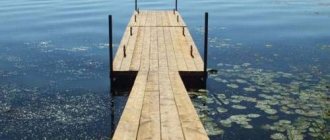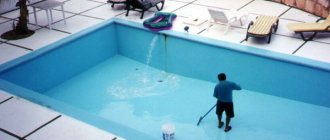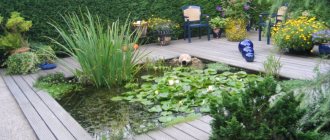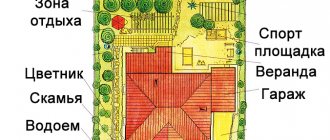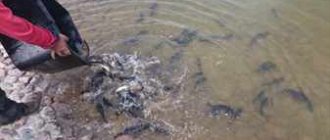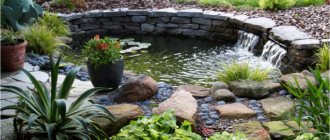Methods for cleaning artificial ponds
Spring is the most important time of the year, since in addition to work on the site, caring for the water body is added. The best thing you can do for a pond in your country house or in your yard is to clean it - be it a deep cleaning or a small sanitary cleaning. To decide what kind of pond cleaning will be needed this season: chemical, mechanical, biological or using ultraviolet radiation, you need to determine the degree of its contamination.
You should check if there is a layer of dirt and all kinds of sediments at the bottom that have sunk to the bottom, whether the water is light or dark in color, so it will become clear what needs to be cleaned - the bottom of the reservoir or just the surface. After clarifying these aspects, it will be possible to choose an acceptable technology and cleaning method, and decide on the selection of the necessary devices, equipment, and tools for the work. You may even have to resort to the use of special equipment or use the services of professionals.
The best time to clean a pond is early spring, ideally before the water temperature exceeds +12...+13ºС. If cleaning is done when the water is warmer, after bacterial colonies have formed, the balance of the ecosystem will be disrupted. In this case, the pond will experience another period of algae blooms before the bacterial colonies are restored. Once you understand what the different cleaning methods are, you can choose the one that suits you.
Biological
The biological treatment option naturally contributes to the restoration of the ecosystem of the water space at the dacha. There is no need to temporarily resettle fish or remove greenery.
Important! Cleaning frequency is an important factor. The optimal frequency of pond cleaning is once a year. This can be done less frequently throughout the year by using nets to prevent leaf accumulation and remove plant debris.
To purify the water space biologically you need:
- breed ameliorators (herbivorous fish) - golden crucian carp, tench or tilapia, which are suitable for growing in heavily silted reservoirs;
- plant higher plants - giant reed, hogweed, calamus, bramble, water lily, reed, arrowhead and many others. etc.;
- use specially created strains of microorganisms (preparations: “Komplezim”, “Vodoem Physitabs”). Such products should be used strictly according to the instructions, without exceeding the dosage;
- choose a biological filter . It is recommended to install it during the construction of the reservoir. Thanks to properly selected filtration, it will be possible to obtain a natural ecosystem that will have biological balance, which will help simplify pond cleaning.
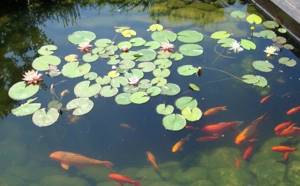
Chemical
Floating aquatic weeds are detrimental to the health of a lake or pond. Over time, they can prevent sunlight from reaching deeper-growing plants, reducing photosynthesis and oxygen production needed by fish and other aquatic life. Duckweed is the vegetation that gives the pond an unsightly appearance. It lives in nutrient-rich bodies of water, such as garden ponds. Such vegetation can slowly destroy the lives of some of its inhabitants. This process can be controlled. Some owners of non-flowing water tanks use chemical cleaning agents.
Important! When using powerful chemicals, it is necessary to exclude even a minimal increase in dosage, otherwise such a drug will not be beneficial, but harmful to fish and other living organisms.
These include:
- "Markopul Chemicals" - the reagent is based on polymer ammonium compounds. It helps to destroy plankton spores, blocking the process of intercellular exchange of algae, which leads to their destruction.
- “Hth Algaecide” - the drug is based on chlorine. The advantage of the product is that it does not lead to a change in pH level when destroying unwanted vegetation.

A type of chemical purification is the sorption method of purifying a reservoir. It works well for eliminating algae and duckweed. People whose property is near fields should be reminded that agricultural chemicals can cause algae blooms in the pond. Zeolite, which acts as an ion exchanger, is called a mineral of the 21st century and an excellent cleaner. It is capable of destroying toxic substances such as ammonia and nitrates.
It is introduced into the filter of the water circulation device (if there is one in the pond). Purified water will stop the growth of algae and duckweed. Over a large area, you can eliminate duckweed colonies by scattering zeolite on the bottom of the reservoir at the rate of 2-3 kg per area of 10 m². The effect of this sorption cleaning method will last 1-2 years.
Did you know? Oldest known dam in the world
-
Java.
It was built around 3000 BC. e. for storing water in order to irrigate or water crops with it in the future. There are factors that contribute to lower pH in ponds. Rain usually has an acid alkaline reaction of 5.2 to 5.6, but industrial pollution can reduce it to 2.5. In areas with coniferous forests, rain penetrates through the pine needles, making the pH even more acidic. Over time, this leaches all the minerals from the soil. In addition, the clay bottom also has an acidic alkaline reaction, and decomposing plants can release additional acids.
Lime is ground limestone (calcium carbonate) that neutralizes these acids and acts as a buffer to prevent rapid pH changes. Often, owners of ponds and lakes carry out liming of the bottom of the reservoir, since over time the amount of lime in it decreases and, if the object is not saturated with this chemical element, parasites will appear in the water and it will become cloudy.

The best way to carry out liming is to evenly distribute the chemical substance along the bottom of the reservoir by applying it using a hose. The least preferred method is to spread lime around the edge of the pond.
Quicklime can perform important functions for the entire pond ecosystem:
- saturate with oxygen;
- eliminates the acidity of the soil;
- will accelerate mineralization.
However, it is worth remembering that on poor sandy soils the idea of liming will be a waste of time. If a large amount of silt is found at the bottom of the pond, then 0.1 kg of lime mass is added to a reservoir area of 10 m² at a meter depth. To carry out liming, you will need a scoop with which you will add chemicals. Every 2 weeks from the beginning of May to mid-June, you need to repeat this procedure.
Determining the degree of pollution of a reservoir
The first thing you need to pay attention to when cleaning a pond is the degree of contamination. The first stage is eutrophication, a decrease in oxygen in water. This happens if you do not remove debris, leaves and branches from the surface of the reservoir in time. At the second stage, duckweed begins to grow, insects, frogs and other inhabitants appear. The third stage is the appearance of silt, which covers the bottom of the pool and subsequently causes re-pollution. At the last, fourth stage, shallowing occurs: the pond is heavily covered with silt, duckweed, and various vegetation, and the reservoir may dry out completely.
Determining the degree of contamination helps to select the necessary cleaning method and effective means.
Can it be cleaned with a drainage or fecal pump?
There is innovative equipment - hand-held mini dredgers that can remove bottom sediments in artificial reservoirs. Portable pumps of various Piranha models have proven themselves well.
Some pond owners claim that a sump pump can only handle the task of cleaning a small pond. They recommend doing this process in the spring during the flood period, pouring mud and water onto a field or garden. With a small amount of water, you can clean it through a sand filter. However, there are those who insist on purifying a water body only with a fecal pump, since it is the one that can 100% cope with the task. It is worth noting that powerful equipment capable of coping with this task is expensive, so it may make sense to think about renting it or hiring specialists for such work.
You will be interested in learning about ways to fill a pond with water.
How to best clean the bottom and surface of a pond
Completely pumping out the water from an artificial pond should always be the last method used to clean the water body. As a result, the reservoir may become even dirtier in the future, as the natural ecosystem will be disrupted. Even if the water in the pond looks dirty or cloudy, this does not always mean it is of poor quality and needs to be drained.
It has many microorganisms and millions of beneficial bacteria. They constantly work to destroy harmful substances such as ammonia and nitrites. Beneficial microorganisms are essential for fish ponds. They form the basis of the “nitrogen cycle” because they are able to maintain balance in the pond. Replenishing more water after draining can cause even more damage because tap water is usually high in chlorine, which is toxic to most naturally occurring microorganisms.
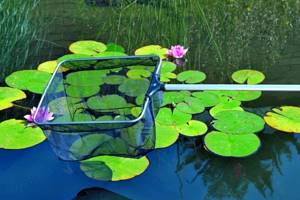
If the level of pollution has increased, you need to manually (with a scoop, rake or special net) remove debris from the surface of the reservoir. To create circulation at the bottom of the pond, it is necessary to use bottom drainage systems, aeration units, and circulation nozzles.
Vacuuming the bottom of the pond is very convenient today. Modern vacuum cleaners have two pumps for constant vacuuming, thanks to which you can get high-quality cleaning without negative side effects.
Rules for caring for a pond
You need to systematically care for the pond on your property, without waiting for the moment when only specialists with special equipment can help. The contents of the reservoir will change from time to time, depending on the season.
There is a lot of maintenance work in spring and summer:
- planting new plants;
- timely removal of debris from the surface of the reservoir;
- feeding fish;
- maintaining water purity;
- installation of sand or gravel filters;
- adding clean water to maintain salt balance.
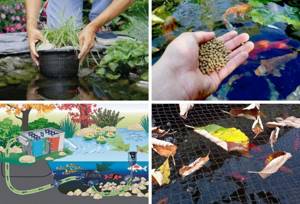
In autumn and winter, the main issue is maintaining the viability of the pond. Dead plant parts and fallen leaves should be removed before they sink to the bottom. To maintain healthy fish and clean water, you don't want to overload the ecosystem with too many fish.
Manicured ponds are beautiful, serene places to gather to relax. An ideal body of water is not one that is beautiful only at first, but one that is beautiful year after year. Only with regular cleaning, removal of dirt and maintenance can the desired result be achieved.
Changing water
It is not always possible to clean a pond at your dacha with your own hands without draining it. Sometimes the contamination is so severe that only a partial or complete water change can help. To do this, liquid is drained from the reservoir, and live plants and fish are transferred to a temporary container with water. The silt should be pumped out from the bottom with a vacuum cleaner, debris should be collected, the bottom should be cleared of clay, after which the pond can be filled again.
To determine whether the time has come for this procedure, you can lower a white plate into the water. If it is not visible at a depth of 10 cm, it is time to change the water.
You can, of course, get by with filtration and other methods, but if there is significant contamination, this will take a lot of time and effort. Therefore, if the reservoir is very overgrown and cloudy, it is recommended to completely drain the water. A private, beautiful and well-kept pond is the dream of many owners of private residential buildings. Each owner must decide on a method for cleaning a reservoir from duckweed, as well as other contaminants, independently, guided by the size and functional purpose of the reservoir. You can clean a pond at your dacha with your own hands using any of the following methods - and you will maintain the balance of its unique ecosystem.
